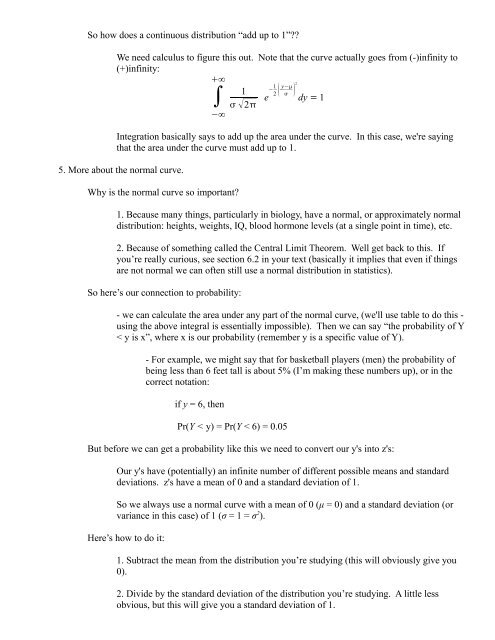n ypy
n ypy
n ypy
Create successful ePaper yourself
Turn your PDF publications into a flip-book with our unique Google optimized e-Paper software.
So how does a continuous distribution “add up to 1”??<br />
We need calculus to figure this out. Note that the curve actually goes from (-)infinity to<br />
(+)infinity:<br />
∞<br />
1<br />
∫ 2<br />
e−1 2 y−<br />
2<br />
<br />
dy = 1<br />
−∞<br />
Integration basically says to add up the area under the curve. In this case, we're saying<br />
that the area under the curve must add up to 1.<br />
5. More about the normal curve.<br />
Why is the normal curve so important?<br />
1. Because many things, particularly in biology, have a normal, or approximately normal<br />
distribution: heights, weights, IQ, blood hormone levels (at a single point in time), etc.<br />
2. Because of something called the Central Limit Theorem. Well get back to this. If<br />
you’re really curious, see section 6.2 in your text (basically it implies that even if things<br />
are not normal we can often still use a normal distribution in statistics).<br />
So here’s our connection to probability:<br />
- we can calculate the area under any part of the normal curve, (we'll use table to do this -<br />
using the above integral is essentially impossible). Then we can say “the probability of Y<br />
< y is x”, where x is our probability (remember y is a specific value of Y).<br />
- For example, we might say that for basketball players (men) the probability of<br />
being less than 6 feet tall is about 5% (I’m making these numbers up), or in the<br />
correct notation:<br />
if y = 6, then<br />
Pr(Y < y) = Pr(Y < 6) = 0.05<br />
But before we can get a probability like this we need to convert our y's into z's:<br />
Our y's have (potentially) an infinite number of different possible means and standard<br />
deviations. z's have a mean of 0 and a standard deviation of 1.<br />
So we always use a normal curve with a mean of 0 (μ = 0) and a standard deviation (or<br />
variance in this case) of 1 (σ = 1 = σ 2 ).<br />
Here’s how to do it:<br />
1. Subtract the mean from the distribution you’re studying (this will obviously give you<br />
0).<br />
2. Divide by the standard deviation of the distribution you’re studying. A little less<br />
obvious, but this will give you a standard deviation of 1.
















